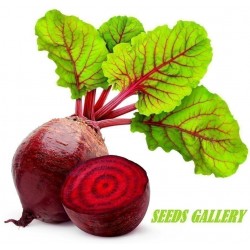Menu
-
MenuWstecz
- Home
-
Kategorie
-
-
Kategorie
-
Nasiona warzyw
-
Odmiany według kraju
- Odmiany z Armenii
- Odmiany z BiH
- Odmiany z Chorwacji
- Odmiany z Francji
- Varieties from Germany
- Varieties from Greece
- Varieties from Hungary
- Odmiany z Indii
- Varieties from Italy
- Odmiany z Japonii
- Odmiany z North Macedonii
- Varieties from Peru
- Varieties from Russia
- Varieties from Serbia
- Odmiany ze Słowenii
- Varieties from Spain
- Varieties from Thailand
- Odmiany z Turcji
- Varieties from USA
- Nasiona Pomidorów
- Nasiona kukurydzy
- Gurda rodziny
- Rodzina fasoli
- Nasiona Ogórka
- Nasiona Papryki
- Rodzina marchwi
- Rodzina cebuli
- Nasiona Sałaty
- Rodzina ziemniaków
- Rodzina kapuściana
- Nasiona Rzodkiewki
- Rodzina buraków
- Nasiona arbuza
- Nasiona melona
- Nasiona kalafiora
- Rodzina słoneczników
-
Odmiany według kraju
- Nasiona Owoców
- Nasiona Papryki Chili
- Nasiona ziół leczniczych
- Nasiona roślin pnących
- Drzewa - Krzewy - Nasiona
- Nasiona palmy
- Nasiona Traw Ozdobnych
- Nasiona tytoniu
-
Nasiona warzyw
-
-
-
-
- NOWE PRODUKTY
- Dostawa - płatność
- Utwórz konto
- FAQ
Last Product Reviews
Out of the two seeds, one germinated and the other one was dead and floatin...
By
 Riikka H on 07/03/2024
Riikka H on 07/03/2024
Verified Purchase
Rodzina buraków
Jest 23 produktów.
Pokazano 1-15 z 23 pozycji

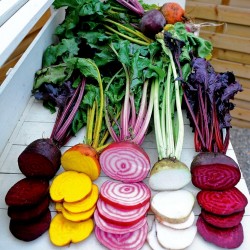
Rainbow Beetroot Seeds
Cena podstawowa
2,00 €
-15%
Cena
1,70 €
(SKU: VE 223)
Seeds Gallery EU,
5/
5
<!DOCTYPE html>
<html>
<head>
<meta http-equiv="Content-Type" content="text/html; charset=UTF-8" />
</head>
<body>
<h2><strong>Rainbow Beetroot Seeds</strong></h2>
<h2><span style="color: #ff0000;"><strong>Price for Package of 55+- (1g) seeds.</strong></span></h2>
<p>A visually stunning mixture of five beetroot varieties with superb contrasting outer skins, flesh, stems and leaves! Each variety has a deliciously sweet flavour and they can be enjoyed as mature roots or as tasty 'baby beets'. Delicious whether they are eaten hot or cold, cooked or pickled, Beetroot 'Rainbow Beet' can even be sliced raw into salads for a colourful crunch. Try steaming the tender stems and leaves as an alternative to spinach or Swiss chard. Height: 30cm (12in). Spread: 15cm (6in).</p>
<p> Collection comprises:</p>
<p> Beetroot 'Subeto' - Deep, rich, purple-red roots with purple stems and green leaves.</p>
<p> Beetroot 'Boldor' - A vibrant globe variety with a yellow flesh and orange outer skin. The yellow stems contrast nicely with the bright green leaves.</p>
<p> Beetroot 'Chioggia' - A striking globe variety with red-pink skin and an appealing 'bullseye' formation of red and white rings on the inside fading to soft pink when cooked. Pink stems.</p>
<p> Beetroot 'Albina Vereduna' - Pure white roots with superb flavour, and pale green stems.</p>
<p> Beetroot 'Bull's Blood Scarletta' - A striking variety with dark burgundy-purple leaves, stems and outer skins. When cut open, roots are cerise pink with attractive concentric rings.</p>
<h3><strong>How To Sow</strong></h3>
<p>Direct sow beetroot seeds outdoors from March to July in a weed-free, sunny position in fertile, light, well-drained soil. Sow beetroot seeds thinly in shallow drills at a depth of 3cm (1") and 30cm (12") apart. Germination will usually take 12 to 24 days. When large enough to handle, thin out the seedlings within each row to 10cm (4") apart.</p>
<h3><strong>Aftercare</strong></h3>
<p>When growing beetroot, water as necessary to prevent the soil from drying out and keep the plants cool and moist. This will help to avoid plants running to seed. Roots can be lifted at any time from June to October once they have reached 3cm (1") diameter or more. Harvest any remaining crops before the first frosts. Beetroot can be stored until mid-spring in boxes of moist sand in a frost free shed or garage.</p>
</body>
</html>
VE 223 (1g)

- -15%
- Nowy
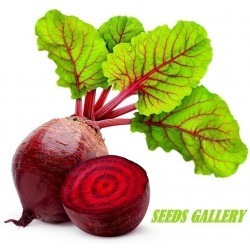
100 Seeds Egyptian Beetroot
Cena podstawowa
1,15 €
-15%
Cena
0,98 €
(SKU: VE 230)
Seeds Gallery EU,
5/
5
<h2 class=""><strong>100 Seeds Egyptian Beetroot (Beta vulgaris)</strong></h2>
<h2 class=""><span style="color: #ff0000;"><strong>Price for Package of 100 seeds.</strong></span></h2>
<div>Heirloom variety dating back to 1800’s that produces a flattish beetroot with dark red flesh that has lighter zones. Excellent old fashioned flavour, eaten raw or cooked. Delicious edible tops</div>
<div>stay green and can be used as spinach or in salads. Early variety. 55 days.</div>
<script src="//cdn.public.n1ed.com/G3OMDFLT/widgets.js"></script>
VE 230 (1,5g)

- -15%
- Nowy
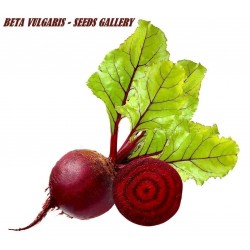
Beetroot Seeds 'Monika'
Cena podstawowa
1,35 €
-15%
Cena
1,15 €
(SKU: VE 33 (1g))
Seeds Gallery EU,
5/
5
<h2><span style="text-decoration: underline;" class=""><em><strong>Beetroot Seeds 'Monika' (Beta vulgaris)</strong></em></span></h2>
<h3><span style="color: #ff0000;"><strong>Price for Package of 100 seeds.</strong></span></h3>
<div>A splendid variety with so many advantages. Virtually no thinning is required, being a monogerm type, and it is also highly bolt-resistant. Perfect for both early and later sowings, we love the baby beets pickled in sweet vinegar.</div>
<div>How to grow Beetroot:</div>
<div>Beetroot are remarkably easy to grow and can be grown across a wide range of climates. It prefers moist, sunny conditions with not excessive heat. It is sown as a warm season crop in most regions, but performs best during the cooler, drier months in tropical zones where it may prefer some shade in summer conditions</div>
<div>Beetroot can be sown from very early in the season until late and can be grown in raised beds or containers all year round. Sow the seeds closer together for cutting and use in baby leaf salads, they can be constantly thinned, as you need them throughout the growing period. The young shoots are also deliciously sweet. </div>
<div>Beetroot seeds are clustered together with each cork-like fruit containing two or three seeds. Once germinated, they require thinning out early to avoid root disturbance. (Some varieties have been bred to only produce one seed and are called 'Monogerm' seeds).</div>
<div>Position:</div>
<div>Beetroot prefer to be grown in light, sandy soil in a sunny position, but can tolerate pretty much any sort of soil and some shade will be tolerated, a pH of 6.0-7.0 is fine but if you know your soil is too acid dig in some lime. </div>
<div>Dig over the site with a spade (preferably in the autumn prior to sowing). Remove perennial weeds and large stones as these can cause the roots to become mis-shapen</div>
<div>Level roughly and then work over the area with a rake to leave a fine finish. If you can, two or three weeks before sowing, spread a general granular fertiliser across the site and rake into the soil. Do not add manure to the soil as this will cause the roots to develop incorrectly.</div>
<div>When to sow Beetroot: Late spring to autumn.</div>
<div>Beetroots can be grown from early spring onwards if grown indoors or undercover. </div>
<div>Seeds can be planted directly into the ground after the threat of frost has passed. Beetroots are best planted at soil temperatures between 7°C and 25°C. The best quality beetroots are grown at temperatures of 10 to 18°C (50 to 65°F).The crops will tolerate light frost.</div>
<div>How to sow Beetroot:</div>
<div>The seeds require plenty of moisture to germinate. Soaking them in warm water for an hour or two prior to planting is a great way to speed up germination. Expected germination time 10 to 14 days. </div>
<div>Prevent a glut when planting beetroot by sowing your seed in stages, a small batch at a time every couple of weeks will give a continuous harvest.</div>
<div>Sowing Indoors: From February</div>
<div>Sow 2 or 3 seeds per pot, at a depth of 25mm (1in). When the seedlings emerge there may be more than one from each seed cluster. When they are about 5cm (2in) tall, carefully separate these into individual plants prior to planting out (only transplant the strongest seedlings). This will avoid seedlings competing with one another and prevent a distorted, misshapen harvest. </div>
<div>Successful transplanting can be carried out as soon as plants have formed their first true leaves. Unlike other root crops, beetroot seedlings transplant reasonably well providing they are not too large and are kept moist when transplanting.</div>
<div>Sowing Direct: From May</div>
<div>It is best to sow beetroot seeds directly into the ground when the temperature of the soil has warmed to about 7°C (44°F). Sow thinly in prepared seed beds. Where plants are sown direct it is important to thin the multiple seedlings back to one plant. If carefully removed, the thinnings can be transplanted to form additional rows.</div>
<div>The spacing is quite important. If you wish to grow small, pickling size beets, they need to be sown quite close together, about 5cm (2in) apart, in rows 15cm (6in) apart. If you wish to grow standard size beetroots, then sow about 10cm (4in) apart, in rows that are at least 30cm (12in) apart.</div>
<div>Cover lightly with 25mm (1in) of fine soil. Firm gently, water well and keep moist. </div>
<div>Seedlings appear in 7 to 21 days. When large enough thin to at least 10cm (4in) apart.</div>
<div>Cultivation: </div>
<div>Keep the rows weed free and the seedlings well watered. Once the roots have developed and they start to swell, beetroots need to be watered moderately. Beetroot has shallow roots and it is important to keep the plants moist. If they experience long dry periods, the beetroot will become hairy and fibrous. Intermittent or inadequate watering can result in stress cracks and breakdown of roots. Don't overwater as this only encourages leaf growth and not bulb growth. </div>
<div>During cool weather, the plants can be watered once a week. During very hot weather, less water can be given two to three times a week instead of a lot of water once a week.</div>
<div>Companion Planting: </div>
<div>Good Companions - Onions, Silverbeet, Kohlrabi, Lettuce, Cabbage, Dwarf Beans. Aromatic Herbs, Celery, Chamomile, Spinach, Chard.</div>
<div>Bad Companions - tall beans, runner beans.</div>
<div>Common Problems: </div>
<div>Boron deficiency is sometimes seen in root vegetable crops. This causes leaf yellowing and scorching. It is very rare if general purpose fertiliser is used that includes trace elements such as boron, magnesium, manganese, iron and molybdenum.</div>
<div>Fungal leaf spots and rust sometimes occur on beetroot leaves. These are worse when plants are poorly grown (lack of sun, water and nutrients) or planted at the wrong time of year. Avoid growing beetroot during most humid time of the year in tropical regions, improve air circulation, reduce nitrogen applications and avoid excessive wetting of the foliage. Apply seaweed sprays to build disease resistance and supply trace elements.</div>
<div>Slugs or snails may eat the leaves. Repellent molasses or chilli spray, or barriers and traps to control slugs and snails may be required in extreme cases.</div>
<div>Propagation:</div>
<div>Beetroot are both wind and insect pollinated; they will cross with silverbeet, chard and other beets. </div>
<div>Plants are biennial, producing vegetative growth in the first season and flowers and seed in the second. If plants bolt, eat do not allow to go to seed.</div>
<div>Do not have two varieties in flower at the same time or isolate plants to keep different strains pure. Where possible, allow at least three to four plants of one variety that show good growth and disease resistance for flowering and seed production.</div>
<div>Harvesting: </div>
<div>Beetroot is ready to be picked when the roots are between the size of a golf ball and a tennis ball – this is usually 12 to 16 weeks after sowing. The smaller the root the better the quality. </div>
<div>Pull from all along the row and not just in one place, as this thins out the rows, allowing more space for the other beetroot to grow. To harvest, gently hold the tops and lift while levering under the root with a hand fork. Remove the tops by twisting them off with your hands to prevent the plants bleeding their juice – don’t throw these away, they have bags of taste and can be cooked and eaten like spinach. Store roots in dry sand, soil, or peat for winter use.</div>
<div>Culinary Uses:</div>
<div>Before cooking beets, cut off the tops within a couple of inches of the top. This helps lock in the nutrients during cooking. When the tops are attached to any root vegetable, they leech the nutrients from the root. They should be cooked whole and then peeled; otherwise, they bleed all their colour and nutrients into the water. </div>
<div>The deep-red roots are eaten Boiled, steamed or roasted as a vegetable (if roasted, cover with lemon juice to stop browning). They can be eaten cold as a salad after cooking and adding oil and vinegar, or raw and shredded. </div>
<div>A large proportion of commercial production is processed into boiled and sterilised beets or into pickles. In Eastern Europe beet soup, such as cold borscht, is a popular dish. Beetroot leaves are lovely in a salad or cooked. Use as you would spinach.</div>
<div>Beetroot can easily be stored for later use, and the most common method is by pickling them in vinegar.</div>
<div>Storing:</div>
<div>The greens and the roots should be stored separately as the greens are highly perishable, but the roots can last for some time in storage. Another method to store beetroot is pickling and making chutney.</div>
<div>Other Uses:</div>
<div>Beetroot is known for staining the tablecloth, but can be used to make an excellent natural dye. It gives a fantastic range of colours, from yellow, through reds to browns, dependent on the type of mordant used. Within older bulbs of beetroot, the colour is a deeper crimson and the flesh is much softer. Beetroot dye may also be used in ink.</div>
<div>Betanin, obtained from the roots, is used industrially as red food colourants, e.g. to improve the colour of tomato paste, sauces, desserts, jams and jellies, ice cream, sweets and breakfast cereals.</div>
<div>Origin:</div>
<div>Beetroot are biennial plants grown as annuals and harvested for their swollen root tuber and leaves. The type of wild plant from which it came, had thin, poor roots and was native to the Mediterranean but spread eastwards into West Asia. It was known as a vegetable as early as 300 BC but was only introduced into Germany and Britain around the sixteenth century.</div>
<div>Beetroots are related to the sugar beet and to swiss chard, the foliage beets that are grown for the greens and not the root.</div>
<div>History: </div>
<div>From the Middle Ages, beetroot was used as a treatment for a variety of conditions, especially illnesses relating to digestion and the blood. Platina recommended taking beetroot with garlic to nullify the effects of 'garlic-breath'.</div>
<div>Since Roman times, beetroot juice has been considered an aphrodisiac and natural Viagra. </div>
<div>It is a rich source of the element boron, which plays an important role in the production of human sex hormones. Field Marshal Montgomery is reputed to have exhorted his troops to 'take favours in the beetroot fields', a euphemism for visiting prostitutes.</div>
<script src="//cdn.public.n1ed.com/G3OMDFLT/widgets.js"></script>
VE 33 (1g)

- -15%
- Nowy
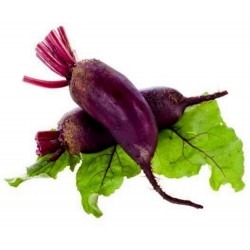
Beetroot Seeds Cylindra
Cena podstawowa
1,95 €
-15%
Cena
1,66 €
(SKU: VE 31 (1g))
Seeds Gallery EU,
5/
5
<div class="container">
<div class="row">
<div class="col-12">
<h2><span style="text-decoration: underline;" class=""><em><strong>Beetroot Seeds “Cylindra” (Beta vulgaris var. crassa)</strong></em></span></h2>
<h3><span style="color: #ff0000;"><strong>Price for Package of 100 seeds.</strong></span></h3>
<div>Beetroot Cylindra, as its name suggests is a cylindrical (half-long or stump-rooted) beetroot. Smooth-skinned with dark purple-red flesh, it grows a dark red, elongated root 7 to 10cm (6 to 8in) long. </div>
<div>This unique variety has a very fine, smooth texture with little fibre, the root maintains its sweetness and tenderness over a long growing season and does not get woody. </div>
<div>The roots are sweet with an earthy-caramel taste, especially lovely when roasted. The roots stand proud above the soil, but can be earthed up, and remain in good condition a long period. The red-green leaves are sweeter and more “beety” tasting than other beet leaves.</div>
<div>Beetroot Cylindra matures medium early, a little more slowly than globe-shaped beetroot, but because of its cylindrical root shape can be and can be spaced more closely together, making it productive in small spaces. Because of its uniform width, it is ideal for cutting into uniform slices (it is sometimes called Butter Slicer), perfect for slicing, pickling and canning. </div>
<div>There are quite a number of myths about this beautiful beetroot.</div>
<div>Some sources, both on the web and printed in books, state that Cylindra is an old English or Danish variety. ('recorded by 1840 and widely grown by 1880'.), but Cylindra is apparently a relatively young beetroot. It was first brought to market and entered in a French catalogue in 1968-69. We have not managed to find earlier references, which mentions Cylindra.</div>
<div>Several sources also refer to Cylindra being synonymous with Formanova, again, we have not managed to find sources, which have confirmed this.</div>
<div>How to grow Beetroot:</div>
<div>Beetroot are remarkably easy to grow and can be grown across a wide range of climates. It prefers moist, sunny conditions with not excessive heat. It is sown as a warm season crop in most regions, but performs best during the cooler, drier months in tropical zones where it may prefer some shade in summer conditions</div>
<div>Beetroot can be sown from very early in the season until late and can be grown in raised beds or containers all year round. Sow the seeds closer together for cutting and use in baby leaf salads, they can be constantly thinned, as you need them throughout the growing period. The young shoots are also deliciously sweet. </div>
<div>Beetroot seeds are clustered together with each cork-like fruit containing two or three seeds. Once germinated, they require thinning out early to avoid root disturbance. (Some varieties have been bred to only produce one seed and are called 'Monogerm' seeds).</div>
<div>Position:</div>
<div>Beetroot prefer to be grown in light, sandy soil in a sunny position, but can tolerate pretty much any sort of soil and some shade will be tolerated, a pH of 6.0-7.0 is fine but if you know your soil is too acid dig in some lime. </div>
<div>Dig over the site with a spade (preferably in the autumn prior to sowing). Remove perennial weeds and large stones as these can cause the roots to become mis-shapen</div>
<div>Level roughly and then work over the area with a rake to leave a fine finish. If you can, two or three weeks before sowing, spread a general granular fertiliser across the site and rake into the soil. Do not add manure to the soil as this will cause the roots to develop incorrectly.</div>
<div>When to sow Beetroot: Late spring to autumn.</div>
<div>Beetroots can be grown from early spring onwards if grown indoors or undercover. </div>
<div>Seeds can be planted directly into the ground after the threat of frost has passed. Beetroots are best planted at soil temperatures between 7°C and 25°C. The best quality beetroots are grown at temperatures of 10 to 18°C (50 to 65°F).The crops will tolerate light frost.</div>
<div>How to sow Beetroot:</div>
<div>The seeds require plenty of moisture to germinate. Soaking them in warm water for an hour or two prior to planting is a great way to speed up germination. Expected germination time 10 to 14 days. </div>
<div>Prevent a glut when planting beetroot by sowing your seed in stages, a small batch at a time every couple of weeks will give a continuous harvest.</div>
<div>Sowing Indoors: From February</div>
<div>Sow 2 or 3 seeds per pot, at a depth of 25mm (1in). When the seedlings emerge there may be more than one from each seed cluster. When they are about 5cm (2in) tall, carefully separate these into individual plants prior to planting out (only transplant the strongest seedlings). This will avoid seedlings competing with one another and prevent a distorted, misshapen harvest. </div>
<div>Successful transplanting can be carried out as soon as plants have formed their first true leaves. Unlike other root crops, beetroot seedlings transplant reasonably well providing they are not too large and are kept moist when transplanting.</div>
<div>Sowing Direct: From May</div>
<div>It is best to sow beetroot seeds directly into the ground when the temperature of the soil has warmed to about 7°C (44°F). Sow thinly in prepared seed beds. Where plants are sown direct it is important to thin the multiple seedlings back to one plant. If carefully removed, the thinnings can be transplanted to form additional rows.</div>
<div>The spacing is quite important. If you wish to grow small, pickling size beets, they need to be sown quite close together, about 5cm (2in) apart, in rows 15cm (6in) apart. If you wish to grow standard size beetroots, then sow about 10cm (4in) apart, in rows that are at least 30cm (12in) apart.</div>
<div>Cover lightly with 25mm (1in) of fine soil. Firm gently, water well and keep moist. </div>
<div>Seedlings appear in 7 to 21 days. When large enough thin to at least 10cm (4in) apart.</div>
<div>Cultivation: </div>
<div>Keep the rows weed free and the seedlings well watered. Once the roots have developed and they start to swell, beetroots need to be watered moderately. Beetroot has shallow roots and it is important to keep the plants moist. If they experience long dry periods, the beetroot will become hairy and fibrous. Intermittent or inadequate watering can result in stress cracks and breakdown of roots. Don't overwater as this only encourages leaf growth and not bulb growth. </div>
<div>During cool weather, the plants can be watered once a week. During very hot weather, less water can be given two to three times a week instead of a lot of water once a week.</div>
<div>Companion Planting: </div>
<div>Good Companions - Onions, Silverbeet, Kohlrabi, Lettuce, Cabbage, Dwarf Beans. Aromatic Herbs, Celery, Chamomile, Spinach, Chard.</div>
<div>Bad Companions - tall beans, runner beans.</div>
<div>Common Problems: </div>
<div>Boron deficiency is sometimes seen in root vegetable crops. This causes leaf yellowing and scorching. It is very rare if general purpose fertiliser is used that includes trace elements such as boron, magnesium, manganese, iron and molybdenum.</div>
<div>Fungal leaf spots and rust sometimes occur on beetroot leaves. These are worse when plants are poorly grown (lack of sun, water and nutrients) or planted at the wrong time of year. Avoid growing beetroot during most humid time of the year in tropical regions, improve air circulation, reduce nitrogen applications and avoid excessive wetting of the foliage. Apply seaweed sprays to build disease resistance and supply trace elements.</div>
<div>Slugs or snails may eat the leaves. Repellent molasses or chilli spray, or barriers and traps to control slugs and snails may be required in extreme cases.</div>
<div>Propagation:</div>
<div>Beetroot are both wind and insect pollinated; they will cross with silverbeet, chard and other beets. </div>
<div>Plants are biennial, producing vegetative growth in the first season and flowers and seed in the second. If plants bolt, eat do not allow to go to seed.</div>
<div>Do not have two varieties in flower at the same time or isolate plants to keep different strains pure. Where possible, allow at least three to four plants of one variety that show good growth and disease resistance for flowering and seed production.</div>
<div>Harvesting: </div>
<div>Beetroot is ready to be picked when the roots are between the size of a golf ball and a tennis ball – this is usually 12 to 16 weeks after sowing. The smaller the root the better the quality. </div>
<div>Pull from all along the row and not just in one place, as this thins out the rows, allowing more space for the other beetroot to grow. To harvest, gently hold the tops and lift while levering under the root with a hand fork. Remove the tops by twisting them off with your hands to prevent the plants bleeding their juice – don’t throw these away, they have bags of taste and can be cooked and eaten like spinach. Store roots in dry sand, soil, or peat for winter use.</div>
<div>Culinary Uses:</div>
<div>Before cooking beets, cut off the tops within a couple of inches of the top. This helps lock in the nutrients during cooking. When the tops are attached to any root vegetable, they leech the nutrients from the root. They should be cooked whole and then peeled; otherwise, they bleed all their colour and nutrients into the water. </div>
<div>The deep-red roots are eaten Boiled, steamed or roasted as a vegetable (if roasted, cover with lemon juice to stop browning). They can be eaten cold as a salad after cooking and adding oil and vinegar, or raw and shredded. </div>
<div>A large proportion of commercial production is processed into boiled and sterilised beets or into pickles. In Eastern Europe beet soup, such as cold borscht, is a popular dish. Beetroot leaves are lovely in a salad or cooked. Use as you would spinach.</div>
<div>Beetroot can easily be stored for later use, and the most common method is by pickling them in vinegar.</div>
<div>Storing:</div>
<div>The greens and the roots should be stored separately as the greens are highly perishable, but the roots can last for some time in storage. Another method to store beetroot is pickling and making chutney.</div>
<div>Other Uses:</div>
<div>Beetroot is known for staining the tablecloth, but can be used to make an excellent natural dye. It gives a fantastic range of colours, from yellow, through reds to browns, dependent on the type of mordant used. Within older bulbs of beetroot, the colour is a deeper crimson and the flesh is much softer. Beetroot dye may also be used in ink.</div>
<div>Betanin, obtained from the roots, is used industrially as red food colourants, e.g. to improve the colour of tomato paste, sauces, desserts, jams and jellies, ice cream, sweets and breakfast cereals.</div>
<div>Origin:</div>
<div>Beetroot are biennial plants grown as annuals and harvested for their swollen root tuber and leaves. The type of wild plant from which it came, had thin, poor roots and was native to the Mediterranean but spread eastwards into West Asia. It was known as a vegetable as early as 300 BC but was only introduced into Germany and Britain around the sixteenth century.</div>
<div>Beetroots are related to the sugar beet and to swiss chard, the foliage beets that are grown for the greens and not the root.</div>
<div>History: </div>
<div>From the Middle Ages, beetroot was used as a treatment for a variety of conditions, especially illnesses relating to digestion and the blood. Platina recommended taking beetroot with garlic to nullify the effects of 'garlic-breath'.</div>
<div>Since Roman times, beetroot juice has been considered an aphrodisiac and natural Viagra. </div>
<div>It is a rich source of the element boron, which plays an important role in the production of human sex hormones. Field Marshal Montgomery is reputed to have exhorted his troops to 'take favours in the beetroot fields', a euphemism for visiting prostitutes.</div>
</div>
</div>
</div><script src="//cdn.public.n1ed.com/G3OMDFLT/widgets.js"></script>
VE 31 (1g)

- -15%
- Nowy
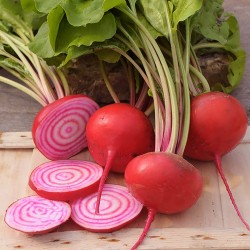
Exotic Beetroot Seeds -...
Cena podstawowa
1,55 €
-15%
Cena
1,32 €
(SKU: VE 123)
Seeds Gallery EU,
5/
5
<h2><strong>Exotic Beetroot Seeds - Chioggia</strong></h2>
<h2><span style="color: #ff0000;"><strong>Price for Package of 15 seeds.</strong></span></h2>
<p>This traditional Italian globe shaped beetroot has dark green leaves and deep red stems. When sliced unusual red and white rings are exposed, adding an attractive element to the salad plate. Sweet taste. Suitable for use in salads or as a hot vegetable.</p>
<p><strong>Sowing Instructions:</strong></p>
<p><strong>Site & Soil</strong></p>
<p>Beetroot's ideal soil is medium to light, although a heavy but well-dug soil will also be OK. What it definitely does not like is a soil which has recently been manured - this will cause the roots to be mis-shapen. The soil should be neutral or slightly alkaline ('pH' 6.5 to 7.5) although it is tolerant of most normal conditions.</p>
<p><strong>When to Sow</strong></p>
<p>Beetroot should be sown when the danger of hard frost has passed, mid-April is about right. In order to avoid glut, plant in small batches up until mid-July. If you want beetroot crops three or four weeks earlier, use a small poly-tunnel or cloche. Simply place the poly-tunnel in position two weeks before sowing (to warm up the soil), then sow the seed three or four weeks earlier than normal.</p>
<p><strong>How to Sow</strong></p>
<p>With a trowel, scoop out a line in the soil about 2.5cm (1in) deep - where more than one line is to be planted, space each line about 30cm (1ft) apart. Space the seeds in the lines 5cm (2in) apart and cover with soil. Water if the soil is dry.</p>
VE 123 (15 S)

- -15%
- Nowy
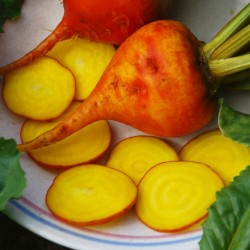
Golden Beetroot Seeds...
Cena podstawowa
1,95 €
-15%
Cena
1,66 €
(SKU: VE 35 GB)
Seeds Gallery EU,
5/
5
<meta http-equiv="Content-Type" content="text/html; charset=UTF-8" />
<h2><strong>Golden Beetroot Seeds Golden Detroit</strong></h2>
<h2><span style="color: #ff0000;"><strong>Price for Package of 25 seeds</strong></span></h2>
<p>This is a productive variety of golden yellow beetroot that produces extremely large fruits, delicious flavor, golden-yellow color retained when cooked. It is used as an ordinary beetroot and can be used for sweet as well as for preparing many other dishes, as well as for arranging.</p>
<p>Its greatest advantage is its taste, which is pleasant in contrast to the heavy taste of ordinary beetroot. Mature roots do not become fibrous.</p>
<p>From this beetroot, your hands will not be colored like by ordinary beetroot.</p>
<p>In addition, the leaves can be harvested and utilized as spinach throughout the season. Good resistance to bolting (What is Bolting? When a plant goes to flower, tastes of the plant will change) and stores well. </p>
<p>Ripening time: 55 days.</p>
<p>If you sow after every few weeks over the summer, you will be supplied with these vegetables until late summer.</p>
<p>Sow seeds in spring after the last frost.</p>
<p>Sow 1cm deep in rows 30cm apart.</p>
<p>Pre-soaking seed in warm water 1 hour before sowing will speed up germination.</p>
VE 35 GB (25 S)

- -15%
- Nowy
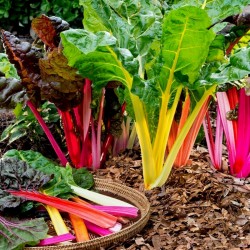
Swiss Chard Rainbow Seeds
Cena podstawowa
1,90 €
-15%
Cena
1,62 €
(SKU: VE 11 (1g))
Seeds Gallery EU,
5/
5
<!DOCTYPE html>
<html>
<head>
<meta http-equiv="Content-Type" content="text/html; charset=UTF-8" />
</head>
<body>
<h2><strong>Swiss Chard Rainbow Seeds</strong></h2>
<h2><span style="color: #ff0000;"><strong>Price for Package of 55+- (1g) seeds.</strong></span></h2>
<p>Rainbow chard, which is extremely popular not only because of its rich colors! Remains a bit smaller than the white Swiss chard, but is more resistant and withstands winter protection even when planted outdoors. The outer leaves are harvested, if the weather permits, this can be done until the end of November. The stems can be cooked or steamed as vegetables, the young leaves are also for raw consumption e.g. best suited in salads. Because of its color, it is also a real eye-catcher as a decorative plant in the perennial border. It should be in a sunny location on freshly moist soil.</p>
<p>Origin: France</p>
<p>Ripening time: 70 days (medium early)</p>
<p>Leaves: medium to 40 cm</p>
<p>Plant height: 50 cm</p>
</body>
</html>
VE 11 (1g)

- -15%
- Nowy
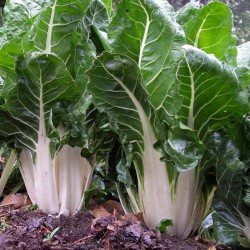
Swiss Chard Seeds White Silver
Cena podstawowa
1,45 €
-15%
Cena
1,23 €
(SKU: VE 99 (1,9g))
Seeds Gallery EU,
5/
5
<h2 class=""><strong>Swiss Chard Seeds 'White Silver'</strong></h2>
<h2><span style="color: #ff0000;"><strong>Price for Package of 100 (1.9g) or 1600 (20g) seeds.</strong></span></h2>
<div>
<div>Chard 'White Silver' has the best flavour of any chard and looks wonderful with its chunky white-stems. A hugely long producing and worthwhile plant. Chard is one of my desert island veg because you can pick it for months on end and there are so many fantastic ways to cook it . Make sure to strip the white from the green, as they have different cooking times.</div>
<div>For a delicious, nutritious and quick recipe for chard, try out a simple Chard and Coconut Soup for a family dinner.</div>
</div>
<div>Companion Plants: Celery, cucumbers, dill, garlic, hyssop, lettuce, mint, nasturtium, onions, potatoes, rosemary, sage, spinach, </div>
<div> </div>
<table border="0">
<tbody>
<tr>
<td><span style="color: #008000;"><strong>Name & Variety</strong></span></td>
<td><span style="color: #008000;"><em>Chard 'White Silver' </em>(Beet Leaf, Beta vulgaris subsp. cicla)</span></td>
</tr>
<tr>
<td><span style="color: #008000;"><strong>Soil Type:</strong></span></td>
<td><span style="color: #008000;">Richly manured ground. They like a rich soil, so dig in lots of organic material to planting position.</span></td>
</tr>
<tr>
<td><span style="color: #008000;"><strong>Site:</strong></span></td>
<td><span style="color: #008000;">Full sun or partial shade</span></td>
</tr>
<tr>
<td><span style="color: #008000;"><strong>Sowing Seed:</strong></span></td>
<td><span style="color: #008000;">For a constant supply throughout the year, sow undercover from February - March then direct sow in April - early September. Easy germination.</span></td>
</tr>
<tr>
<td><span style="color: #008000;"><strong>Spacing:</strong></span></td>
<td><span style="color: #008000;">Plant seedlings 60cm apart if in rows. Sow 3-4 seeds in stations 23cm apart - leaving 35cm between the rows.</span></td>
</tr>
<tr>
<td><span style="color: #008000;"><strong>Hardiness:</strong></span></td>
<td><span style="color: #008000;">Hardy</span></td>
</tr>
<tr>
<td><span style="color: #008000;"><strong>Care tips:</strong></span></td>
<td><span style="color: #008000;">Protect with cloches in winter for good quality growth.</span></td>
</tr>
<tr>
<td><span style="color: #008000;"><strong>Harvesting:</strong></span></td>
<td><span style="color: #008000;">The leaves will produce all year in the South or from April to December in the North. Harvest small leaves for salad from 8 weeks after sowing - a brilliant cut-and-come again crop.</span></td>
</tr>
<tr>
<td><span style="color: #008000;"><strong>Cooking Notes:</strong></span></td>
<td><span style="color: #008000;">Separate the white and the green for cooking, the white stems take 2-3 minutes longer (about 8mins) than the green leaves (5mins).</span></td>
</tr>
</tbody>
</table>
<script src="//cdn.public.n1ed.com/G3OMDFLT/widgets.js"></script>
VE 99 (1,9g)

- -15%
- Nowy

Gigantyczna roślina (z gigantycznymi owocami)
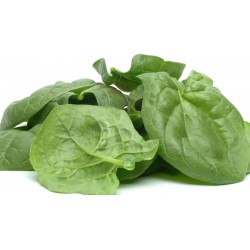
Spinach Seeds GIANT AMERICAN
Cena podstawowa
2,15 €
-15%
Cena
1,83 €
(SKU: VE 43 (2g))
Seeds Gallery EU,
5/
5
<h2><strong>Spinach Seeds GIANT AMERICAN</strong></h2>
<h2><span style="color: #ff0000;"><strong>Price for Package of 160 (2g) seeds.</strong></span></h2>
<p><span style="color: #000000;">A really dark green spinach with heavily blistered, rounded leaves on semi-erect plants.</span></p>
<p><span style="color: #000000;">The dark green heavily blistered leaves of Giant American can be harvested all through the summer and autumn months. A very productive variety.</span></p>
<p><span style="color: #000000;"> </span></p>
<p><span style="color: #000000;">Produces masses of heavily blistered dark green leaves.</span></p>
<p><span style="color: #000000;">Thin, juicy and sweetly flavoured.</span></p>
<p><span style="color: #000000;">Harvest during the summer and autumn.</span></p>
<p><span style="color: #000000;">Suitable For - Vegetable plot, raised beds, container garden, limited space, window boxes</span></p>
<p><span style="color: #000000;"> </span></p>
<p><span style="color: #000000;">Sowing Months - March - August</span></p>
<p><span style="color: #000000;">Harvest - May - November</span></p><script src="//cdn.public.n1ed.com/G3OMDFLT/widgets.js"></script>
VE 43 (2g)

- -15%
- Nowy
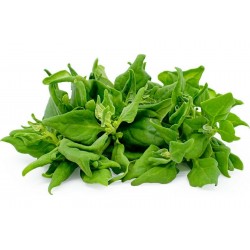
New Zealand Spinach Seeds...
Cena podstawowa
1,85 €
-15%
Cena
1,57 €
(SKU: P 448 NZ)
Seeds Gallery EU,
5/
5
<h2><strong>New Zealand Spinach Seeds (Tetragonia tetragonoides)</strong></h2>
<h2><span style="color:#ff0000;"><strong>Price for Package of 10 seeds.</strong></span></h2>
<p>Tetragonia tetragonoides, commonly called New Zealand spinach and other local names, is a flowering plant in the fig-marigold family (Aizoaceae). It is often cultivated as a leafy vegetable.</p>
<p>It is a widespread species, native to eastern Asia, Australia, and New Zealand. It has been introduced and is an invasive species in many parts of Africa, Europe, North America, and South America. Its natural habitat is sandy shorelines and bluffs, often in disturbed areas. It is a halophyte and grows well in the saline ground.</p>
<p>The plant has a trailing habit and will form a thick carpet on the ground or climb through other vegetation and hang downwards. It can have erect growth when young. The leaves of the plant are 3–15 cm long, triangular in shape, and bright green. The leaves are thick and covered with tiny papillae that look like water drops on the top and bottom of the leaves. The flowers of the plant are yellow, and the fruit is a small, hard capsule covered with small horns.</p>
<p><strong>Uses</strong></p>
<p>The species, rarely used by indigenous people as a leaf vegetable, was first mentioned by Captain Cook. It was immediately picked, cooked, and pickled to help fight scurvy, and taken with the crew of the Endeavour.[6] It spread when the explorer and botanist Joseph Banks took seeds back to Kew Gardens during the latter half of the 18th century.[7] For two centuries, T. tetragonioides was the only cultivated vegetable to have originated from Australia and New Zealand.</p>
<p>There are some indications that Māori did eat kōkihi perhaps more regularly. "To counteract the bitterness of the older leaves of this herb, the Māori boiled it with the roots of the convolvulus (pōhue)".</p>
<p><strong>Cultivation</strong></p>
<p>It is grown for the edible leaves and can be used as food or an ornamental plant for ground cover. As some of its names signify, it has similar flavor and texture properties to spinach and is cooked like spinach. Like spinach, it contains oxalates; its medium to low levels of oxalates needs to be removed by blanching the leaves in hot water[10] for one minute, then rinsing in cold water before cooking. It thrives in hot weather and is considered an heirloom vegetable. Few insects consume it, and even slugs and snails do not seem to feed on it.</p>
<p>The thick, irregularly-shaped seeds should be planted just after the last spring frost. Before planting, the seeds should be soaked for 12 hours in cold water, or 3 hours in warm water. Seeds should be planted 5–10 mm (0.2–0.4 in) deep, and spaced 15–30 cm (5.9–11.8 in) apart. The seedlings will emerge in 10–20 days, and it will continue to produce greens through the summer. A mature plant will self-seed. Seeds will overwinter up to USDA zone 5.</p>
<p><strong>Names</strong></p>
<p>This widely distributed plant has many common names, depending on its location. In addition to the name New Zealand spinach, it is also known as Botany Bay spinach, Cook's cabbage, kōkihi (in Māori), sea spinach, and tetragon. Its Australian names of Warrigal Greens and Warrigal Cabbage[6] come from the local use of warrigal to describe plants that are wild (not farmed originally).</p>
P 448 NZ

- -15%
- Nowy
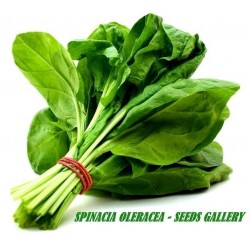
Spinach Seeds Matador
Cena podstawowa
1,65 €
-15%
Cena
1,40 €
(SKU: VE 26 (2g))
Seeds Gallery EU,
5/
5
<h2><strong>Spinach Seeds Matador</strong></h2>
<h2><span style="color: #ff0000;" class=""><strong>Price for Package of 2g (160) seeds.</strong></span><span><strong><span style="color: #ff0000;"><br></span></strong></span></h2>
<p>Spinach Matador is an excellent early all round variety with oval and smooth leaves. Slow bolting spinach with a good mildew resistance. Excellent taste and texture, and is very slow to bolt.</p>
<p>Late sowings will last well into winter. This spinach has it all.</p>
<p>Sow the spinach seeds from early spring or in the autumn outside in a prepared bed 1 cm deep. Rich, weel drained soil is recommended. Thin out to 5-10cm apart as the seedlings appear. Water well in dry spells. Harvest the young leaves as required, picking only a few from each plant.</p>
<p>Easy to grow, annual leaf vegetable. Crops for a long period.</p>
<p>Can be sown in the autumn for winter leaves.</p><script src="//cdn.public.n1ed.com/G3OMDFLT/widgets.js"></script>
VE 26 (2g)

- -15%
- Nowy
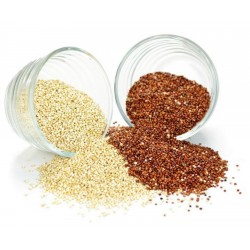
Quinoa Seeds Red or White...
Cena podstawowa
2,00 €
-15%
Cena
1,70 €
(SKU: VE 232)
Seeds Gallery EU,
5/
5
<div class=""rte""><h2><strong>Quinoa Seeds (Chenopodium quinoa)</strong></h2><h2><span style="color:#ff0000;"><strong>Price for Package of 700+- (2g) seeds.</strong></span></h2><p>Quinoa (/ˈkiːnwɑː/, from Quechua kinwa or kinuwa ) is a species of the goosefoot genus (Chenopodium quinoa), a grain crop grown primarily for its edible seeds. It is a pseudocereal rather than a true cereal, as it is not a member of the true grass family. As a chenopod, quinoa is closely related to species such as beetroots, spinach and tumbleweeds. As a member of the Amaranthaceae family, it is related to and resembles amaranth, which is also a pseudocereal.</p><p>It is high in protein, and is tolerant of dry soil.</p><p>Quinoa (the name is derived from the Spanish spelling of the Quechua name kinwa) originated in the Andean region of Peru, Bolivia, Ecuador, Chile and Colombia, where it was domesticated 3,000 to 4,000 years ago for human consumption, though archaeological evidence shows a non-domesticated association with pastoral herding some 5,200 to 7,000 years ago.</p><p>Similar Chenopodium species, such as pitseed goosefoot (Chenopodium berlandieri) and fat hen (Chenopodium album), were grown and domesticated in North America as part of the Eastern Agricultural Complex before maize agriculture became popular. Fat hen, which has a widespread distribution in the Northern Hemisphere, produces edible seeds and greens much like quinoa, but in smaller quantities.</p><p>The nutrient composition is favourable compared with common cereals. Quinoa seeds contain essential amino acids like lysine and acceptable quantities of calcium, phosphorus, and iron.</p><p>After harvest, the seeds must be processed to remove the coating containing the bitter-tasting saponins. The seeds are in general cooked the same way as rice and can be used in a wide range of dishes. The leaves are eaten as a leaf vegetable, much like amaranth, but commercial availability of quinoa greens is limited.</p><p>Chenopodium quinoa is a dicotyledonous annual plant usually about 1–2 metres (3.3–6.6 ft) high. It has broad, generally pubescent, powdery, smooth (rarely) to lobed leaves normally arranged alternately. The woody central stem is branched or unbranched depending on the variety and may be green, red or purple. The flowering panicles arise from the top of the plant or from leaf axils along the stem. Each panicle has a central axis from which a secondary axis emerges either with flowers (amaranthiform) or bearing a tertiary axis carrying the flowers (glomeruliform). The green hypogynous flowers have a simple perianth and are generally bisexual and self-fertilizing. The fruits are about 2 millimetres (0.079 in) in diameter and of various colours—from white to red or black, depending on the cultivar.</p><p><strong>Natural distribution</strong></p><p>Chenopodium quinoa is believed to have been domesticated in the Peruvian Andes from wild or weed populations of the same species. There are non-cultivated quinoa plants (Chenopodium quinoa var. melanospermum) that grow in the area it is cultivated; these may either be related to wild predecessors, or they could be descendants of cultivated plants.</p><p><strong>Saponin content</strong></p><p>In their natural state, the seeds have a coating of bitter-tasting saponins, making them unpalatable. Most of the grain sold commercially has been processed to remove this coating. This bitterness has beneficial effects during cultivation, as it is unpopular with birds and therefore requires minimal protection. The genetic control of bitterness involves quantitative inheritance; lowering the saponin content through selective breeding to produce sweeter, more palatable varieties is complicated by about 10% cross-pollination.</p><p>The toxicity category rating of quinoa saponins treats them as mild eye and respiratory irritants and as a low gastrointestinal irritant. The saponin is a toxic glycoside, a main contributor to its hemolytic effects when combined directly with blood cells. In South America, quinoa saponin has many uses, including as a detergent for clothing and washing and as an antiseptic for skin injuries. High levels of oxalic acid are in the leaves and stems of all species of the Chenopodium genus, and are also in the related genera of the Amaranthaceae family. The risks associated with quinoa are minimal, provided it is properly prepared and the leaves are not eaten to excess.</p><p><strong>Nutritional value</strong></p><p>Quinoa was important to the diet of pre-Columbian Andean civilizations. Quinoa grain has been called a superfood, a term which is not in common use by dietitians and nutrition scientists. Protein content is very high for a cereal/pseudo-cereal (14% by mass), but not as high as most beans and legumes. This includes a "low gluten content" that appears to be well tolerated when consumed at normal levels by people with celiac disease. The protein content per 100 calories is higher than brown rice, potatoes, barley and millet, but is less than wild rice and oats. Nutritional evaluations indicate that quinoa is a source of complete protein. Other sources claim its protein is not complete but relatively high in essential amino acids. Other pseudo grains derived from seeds are similar in complete protein levels; buckwheat is 18% protein compared to 14% for Quinoa; Amaranth, a related species to Quinoa, ranges from 12% to 17.5%.</p><p>Quinoa is a rich source (>20% of the Daily value, DV) of the B vitamins thiamine, riboflavin, vitamin B6, and folate and is a rich source of the dietary minerals iron, magnesium, phosphorus, and zinc. Quinoa is also a good source (10-19% of DV) of the B vitamins niacin and pantothenic acid, vitamin E, and the dietary mineral potassium. The pseudo cereal contains a modest amount of calcium, and thus is useful for vegans and those who are lactose intolerant. It is gluten-free and considered easy to digest. Because of these characteristics, it is being considered a possible crop in NASA's Controlled Ecological Life Support System for long-duration human occupied space flights.</p><p>The grain may be germinated in its raw form to boost its nutritional value, provided that the grains are rinsed thoroughly to remove any saponin.[26] It has a notably short germination period: only 2–4 hours in a glass of clean water is enough to make it sprout and release gases, as opposed to 12 hours with wheat. This process, besides its nutritional enhancements, softens the seeds, making them suitable to be added to salads and other cold foods.</p><h3><strong>Cultivation</strong></h3><p>The plant's growth is highly variable due to a high complexity of different subspecies, varieties and landraces (domesticated plants or animals adapted to the environment in which they originated). However, in general it is undemanding and altitude-hardy. It is grown from coastal regions to over 4,000 m (13,000 ft) in the Andes near the equator, with most of the cultivars being grown between 2,500 metres (8,200 ft) and 4,000 metres (13,000 ft). Depending on the variety, optimal growing conditions are in cool climates with temperatures that vary between −4 °C (25 °F) during the night to near 35 °C (95 °F) during the day. Some cultivars can withstand lower temperatures without damage. Light frosts normally do not affect the plants at any stage of development, except during flowering. Mid-summer frosts during flowering, often occurring in the Andes, lead to sterilization of the pollen. Rainfall conditions are highly variable between the different cultivars, ranging from 300 to 1,000 millimetres (12 to 39 in) during growing season. Growth is optimal with well-distributed rainfall during early growth and development and dry conditions during seed maturation and harvesting.</p><p>Quinoa has been cultivated in the United States, primarily in the high elevation San Luis Valley (SLV) of Colorado where it was introduced in 1982. In this high-altitude desert valley, maximum summer temperatures rarely exceed 30 °C (86 °F) and night temperatures are about 7 °C (45 °F). Due to the short growing season, North American cultivation requires short-maturity varieties, typically of Bolivian origin.</p><h2><strong>Sowing</strong></h2><p>Quinoa plants do best in sandy, well-drained soils with a low nutrient content, moderate salinity, and a soil pH of 6 to 8.5.</p><p>The seedbed must be well prepared and drained to avoid waterlogging. In the Andes, the seeds are normally broadcast over the land and raked into the soil. Sometimes it is sown in containers of soil and transplanted later.</p><p><strong>Cultivation management</strong></p><p>Yields are maximised when 170 to 200 kg (370 to 440 lb) N/hectare is available.[citation needed] The addition of phosphorus does not improve yield. In eastern North America, it is susceptible to a leaf miner that may reduce crop success and which also affects the common weed and close relative Chenopodium album, but C. album is much more resistant.</p><p><strong><em>History and culture</em></strong></p><p><strong>Early history</strong></p><p>Quinoa was first domesticated by Andean peoples around 3,000 to 4,000 years ago. It has been an important staple in the Andean cultures where the plant is indigenous but relatively obscure in the rest of the world. The Incas, who held the crop to be sacred, referred to it as chisaya mama or "mother of all grains", and it was the Inca emperor who would traditionally sow the first seeds of the season using "golden implements". During the Spanish conquest of South America, the colonists scorned it as "food for Indians", and suppressed its cultivation, due to its status within indigenous religious ceremonies. The conquistadors forbade quinoa cultivation for a time and the Incas were forced to grow wheat instead.</p><p>The grain has become increasingly popular in the United States, Canada, Europe, Australia, China and Japan where it is not typically grown, increasing crop value. Between 2006 and early 2013 quinoa crop prices tripled. In 2011, the average price was US$3,115 per ton with some varieties selling as high as $8,000 per ton. This compares with wheat prices of $9 per bushel (about $340 per ton). Since the 1970s, producers’ associations and cooperatives have worked toward greater producer control of the market. The higher prices make it harder for people to purchase, but also brings a livable income for farmers and enables many urban refugees to return to working the land.</p><p>The popularity of quinoa grain in non-indigenous regions has raised concerns over food security. Due to continued widespread poverty in regions where it is produced and because few other crops are compatible with the soil and climate in these regions, it has been suggested that the inflated price disrupts local access to food supplies. In 2013, The Guardian compared it to asparagus cultivated in Peru, a cash crop criticized for excessive water use, as "feeding our apparently insatiable 365-day-a-year hunger for this luxury vegetable" It has been suggested that, as people rise above subsistence-level income, they choose higher-status Western processed foods. However, anthropologist Pablo Laguna states that farmers are still saving a portion of the quinoa crop for their own use, and that the high prices affect nearby city dwellers more, but consumption in cities has traditionally been lower. According to Laguna, the net benefit of increased revenue for farmers outweighs the costs, saying that it is "very good news for small, indigenous farmers". The transformation from a healthy staple food for farming families and communities into a product that is held to be worth too much to keep for oneself and one's family is an ongoing process. It is seen as a valuable resource that can bring in far greater amounts[clarification needed] of cheap, low nutrient foods such as pasta and rice. It used to be seen as a peasant food that provided farming families with a very important source of nutrition, but now occupies a spectrum from an everyday food of urban Bolivia's middle class to a luxury food in the Peruvian capital of Lima where "it sells at a higher per pound price than chicken, and four times as much as rice". Efforts are being made in some areas to distribute it more widely and ensure that farming and poorer populations have access to it and have an understanding of its nutritional importance. These include incorporating it into free school breakfasts and in government provisions distributed to pregnant and nursing women in need.</p><p><strong>Kosher controversy</strong></p><p>Quinoa has become popular in the Jewish community as a substitute for the leavened grains that are forbidden during the Passover holiday. Several kosher certification organizations refuse to certify it as being kosher for Passover, citing reasons including its resemblance to prohibited grains or fear of cross-contamination of the product from nearby fields of prohibited grain or during packaging.</p><p>In December 2013, the Orthodox Union, the world's largest kosher certification agency, announced it would begin certifying quinoa as kosher for Passover.</p><p><strong>International Year of Quinoa</strong></p><p>The United Nations General Assembly declared 2013 as the "International Year of Quinoa" in recognition of ancestral practices of the Andean people, who have preserved it as food for present and future generations, through knowledge and practices of living in harmony with nature. The objective is to draw the world’s attention to the role that quinoa could play in providing food security, nutrition and poverty eradication, in support of achieving Millennium Development Goals.</p><p>The Food and Agriculture Organization of the United Nations is as the Secretariat of the international year. Bolivia has the presidency of the Coordination Committee and Ecuador, Peru and Chile share the vice presidency, with the rapporteurship in the hands of Argentina and France.</p></div>
VE 232 C

- -15%
- Nowy
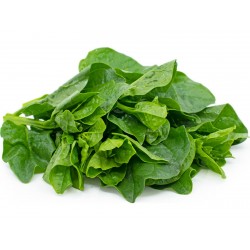
Malabar Spinach, Ceylon...
Cena podstawowa
3,55 €
-15%
Cena
3,02 €
(SKU: VE 226)
Seeds Gallery EU,
5/
5
<h2><b>Malabar Spinach, Vine Spinach, Ceylon Spinach Seeds (Basella alba)</b></h2>
<h2><span style="color: #ff0000;"><b>Price for Package of 10 seeds.</b></span></h2>
<p>Basella alba is an edible perennial vine in the family Basellaceae. It is found in tropical Asia and Africa where it is widely used as a leaf vegetable. It is native to the Indian subcontinent, Southeast Asia and New Guinea. It is reportedly naturalized in China, tropical Africa, Brazil, Belize, Colombia, the West Indies, Fiji, and French Polynesia.</p>
<p>Basella alba is known under various common names, including Malabar spinach, vine spinach, and Ceylon spinach.</p>
<p>Basella alba is a fast-growing, soft-stemmed vine, reaching 10 meters (33 ft) in length.[citation needed] Its thick, semi-succulent, heart-shaped leaves have a mild flavor and mucilaginous texture. It is rich in vitamins A and C, iron and calcium. It has been shown to contain certain phenolic phytochemicals, and it has antioxidant properties</p>
<p>It is also called Malabar Spinach. There are two varieties - green and red. The stem of the Basella alba is green with green leaves and the stem of the cultivar Basella alba 'Rubra' is reddish-purple; the leaves form green and as the plant reaches maturity as a anual, older leaves will develop purple pigment starting at the base of the leave and working towards the end. The stem when crushed usually emits a strong scent. Malabar spinach can be found at many Asian supermarkets, as well as farmers' markets.</p>
<p>Basella alba grows well under full sunlight in hot, humid climates and in areas lower than 500 meters (1,600 ft) above sea level. The plant is native to tropical Asia.[5] Growth is slow in low temperatures resulting in low yields.[citation needed] Flowering is induced during the short-day months of the year. It grows best in sandy loam soils rich in organic matter with pH ranging from 5.5 to 8.0.</p>
<p><b>Uses</b></p>
<p>In the Philippines, the leaves of this vegetable are one of the main ingredients in an all vegetable dish called utan that is served over rice. It is usually cooked with sardines, onions, garlic, and parsley. In Mangalorean Tuluva cuisine, a coconut-based gravy called gassi is paired with the Basella plant, making a delicacy called Basale gassi to be eaten with rice dumplings called pundi soaked overnight in the gravy, or with red rice. Some variations have tiny prawns, clams, horsegram or dried fish in the gravy as well. Beary Muslims of coastal Karnataka prepare Basalede kunhi pindi (small rice dumplings smeared in gravy prepared from Malabar spinach and dried tuna ). In Bengali cuisine it is widely used both in a vegetable dish, cooked with red pumpkin, and in non-vegetarian dishes, cooked with the bones of the Ilish fish and may also be cooked with shrimps. In Andhra Pradesh, a southern state in India, a curry of Basella and Yam is made popularly known as Kanda Bachali Koora [yam and Basella curry]. Also it used to make the snack item bachali koora bajji. In Odisha, India, it is used to make Curries and Saaga (any type of dish made from green leafy vegetables is called Saaga in Odisha). In the Western Ghats in Maharashtra, India, it is used to make bhaji. It is also known as daento or valchi bhaji in Konkani. A common Mangalorean dish is "Valchi bhaji and shrimp - curry". In Gujarat, fresh big and tender leaves are washed, dipped in besan mix and deep-fried to make crispy pakodas, popularly called "poi na bhajia".</p>
<p>The vegetable is used in Chinese cuisine. It has many names including flowing water vegetables. It is often used in stir-frys and soups. In Vietnam, particularly the north, it is cooked with crab meat, luffa and jute to make soup. In Africa, the mucilaginous cooked shoots are most commonly used.</p><script src="//cdn.public.n1ed.com/G3OMDFLT/widgets.js"></script>
VE 226 (10 S)

- -15%
- Nowy

Nasiona Burak pastewny MAMUT
Cena podstawowa
2,25 €
-15%
Cena
1,91 €
(SKU: VE 62 (3g))
Seeds Gallery EU,
5/
5
<h2><strong>Nasiona Burak pastewny MAMUT</strong></h2>
<h2><span style="color: #ff0000;" class=""><strong>Cena za opakowanie 3g (100) nasion.</strong></span></h2>
<p style="color: #202122; font-size: 14px;"><b>Burak pastewny</b><span> </span>– grupa<span> </span>kultywarów<span> </span>podgatunku<span> </span>buraka zwyczajnego<span> </span>(<i>Beta vulgaris</i><span> </span>L. subsp.<span> </span><i>vulgaris</i>). W Polsce jest<span> </span>pastewną<span> </span>rośliną uprawną.</p>
<h2 style="color: #000000; font-size: 1.5em;"><span class="mw-headline" id="Morfologia">Morfologia</span></h2>
<p>Ma grubą, mięsistą<span> </span>bulwę hypokotylową. Od innych odmian buraka różni się tym, że bulwa jest jasna i wystaje górną częścią z ziemi.</p>
<h2 style="color: #000000; font-size: 1.5em;"><span id="Zmienno.C5.9B.C4.87"></span><span class="mw-headline" id="Zmienność">Zmienność</span></h2>
<p>Wyróżnia się trzy jego typy:</p>
<ol>
<li>półcukrowy – najbliższy do<span> </span>buraka cukrowego<span> </span>pod względem wyglądu i zawartości cukru (15-16%),
<dl>
<dd>ma stosunkowo długi korzeń i krótką szyję korzeniową,</dd>
<dd>zanurzony w glebie 2/3,</dd>
<dd>ma wyższe wymagania odnośnie do opadów,</dd>
</dl>
</li>
<li>mamut – korzeń długi, wrzecionowaty, do ½ tkwi w glebie, lekko skręcony korzeń, kolorowe, głowa dłuższa, zawartość cukru do 10%, plon korzeni wyższy niż półcukrowego, jakość gorsza – więcej wody,</li>
<li>walcowaty – walec zakończony małym szpicem, żółty, czerwony, krótka część korzeniowa – 1/3 korzenia, szyja bardzo długa, część korzeniowa tkwi w glebie, można uprawiać na najpłytszych glebach, potrzebuje dużo opadów, bardzo wysoki plon, 6% cukru.</li>
</ol>
<h2 style="color: #000000; font-size: 1.5em;"><span class="mw-headline" id="Zastosowanie">Zastosowanie</span></h2>
<p>Roślina wykorzystywana jest jako<span> </span>pastewna<span> </span>– na paszę dla zwierząt.</p><script src="//cdn.public.n1ed.com/G3OMDFLT/widgets.js"></script>
VE 62 (3g)

- -15%
- Nowy




